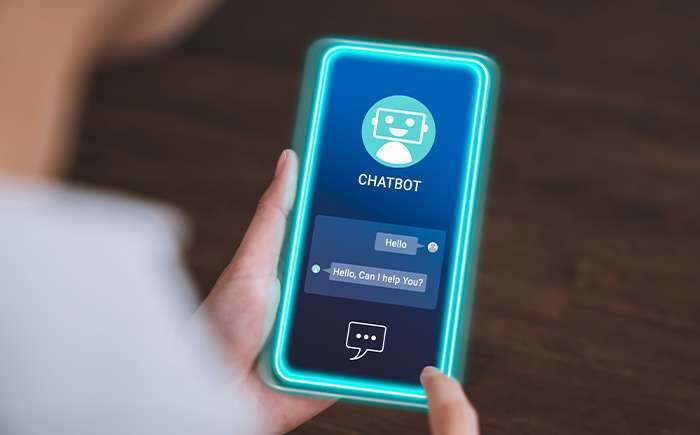- Blog
- An introduction to chatbot AI
An introduction to chatbot AI
In the beginning, there was ELIZA.
The year was 1966 and an MIT professor by the name of Joseph Weizenbaum had a vision of creating a computer program that would mimic human conversation. Using pattern matching and substitution methodology, the German-American computer scientist designed a program that would pair the words that users entered in a computer with a list of possible scripted responses so they would feel like they were interacting with an empathic psychologist. He named his creation ELIZA and the world’s first chatbot was born.

Fast forward to 2021 and Prof Weizenbaum’s vision has resulted in a world where seemingly every company is rushing to jump aboard the chatbot bandwagon and reap the rewards that come with utilising the ground-breaking technology. Siri, Alexa, Einstein and Replika are just a few of the world’s most popular chatbots that are driving a global market expected to be worth an incredible $9.4 billion by 2024. Companies that are yet to develop a chatbot strategy risk being left behind as the technology driving the revolution continues to gather momentum.
This brings us to AI chatbot technology and the fact that the late Prof Weizenbaum would not believe just how far his chatbot dream has come.
Chatbots vs Conversational AI
While the word ‘chatbot’ gets thrown around a lot these days, it is crucial to remember there are essentially two types – scripted chatbots and AI chatbots. The former is the early version of the technology, with ELIZA leading the charge in the 1960s as a text-based mechanism that could reply to a limited set of simple queries with answers that had been pre-written by its developers. Operating like an interactive FAQ, scripted chatbots are programmed to respond in pre-defined ways to specific questions but fail when presented with a complex query or one not envisaged by the developers.
While this style of automated chatbot still has a significant role to play, the growing buzz in the chatbot world stems from how artificial intelligence has taken the concept to another level. AI chatbots are developed using Natural Language Processing (NLP) and Machine Learning (ML) and allow end-users to experience a more conversational tone. More importantly, the latest versions are contextually aware and can learn as they are exposed to more human language.
.png)
Evolution of Conversational AI (source: Deloitte)
A conversational computer program that can learn from the experience? That’s right and that is why the possibilities associated with AI chatbots are seemingly endless.
How do AI Chatbots work?
The mechanism that determines how an AI-enabled chatbot is going to work is its architecture, which primarily depends on three components:
- Natural Language Understanding (NLU)
- Dialogue Manager (DM)
- Natural Language Generation (NLG).
Every AI chatbot is unique, with its development based on a company’s individual requirements and the usability and context of business operations.
- Natural Language Understanding (NLU) Engine: a subset of Natural Language Processing, Natural Language Understanding (NLU) centres on understanding a user’s input or request, classifying their intent and then recognising or extracting the entities. The input provided to the NLU Engine always occurs in text form, with automatic speech recognition converting audio inputs (eg: speech) to text before feeding it to the engine. As for the input, it essentially consists of two things:
- The Intent – an activity the user wants to perform (eg: order a pizza); and
- The Entity – an idea or concept (eg: the pizza itself).
- Dialogue Manager (DM): this key component manages the actual context of the user’s dialogue. Take the situation where a customer says ‘I want to order garlic bread’ but later changes their mind and says ‘Change that to a cheese roll’. A human call agent would realise the customer is clearly referring to their original order (ie: garlic bread) and the Dialogue Manager helps the chatbot do the same, correctly comprehending the change of order and making it in the system.
- Natural Language Generation (NLG): this component marks the end of the architecture and is where the chatbot’s reply is constructed based on the DM output. By converting structured data into text, NLG does the reverse of NLU and contains several outcomes that map to action names. Thus, the appropriate template message is invoked based on the action determined by the Dialogue Manager, with that message then shared with the customer. The chatbot then goes into wait mode pending further input from the customer.
The key is that today’s AI chatbots use NLU to discern the user’s need and then use advanced AI tools to determine what the user is trying to accomplish. The combination of machine learning and deep learning help the program develop an increasing knowledge base of questions and responses based on previous interactions, thus improving its ability to predict future needs and responses.
For example, a traditional chatbot can only respond in basic terms if a user asks for a weather forecast (eg: ‘It will be sunny tomorrow’). Conversely, an AI chatbot can use its knowledge base of previous interactions to not only tell the user it will be sunny but suggest sharing surf conditions for a potential day at the beach.
AI Chatbot uses
The number of uses for AI chatbots are not only extensive – they are increasing as quickly as the technology evolves. From ordering Ubers to engaging with in-home devices such as smart kitchen appliances, daily life is filled with countless moments when everyday people are benefiting from conversational chatbots. Then there is the business world, with marketers using AI chatbots to make customer experiences more personal, IT teams embracing their ability to enable self-service and customer service departments benefiting from streamlined communications.
Specific industries that have been won over by AI chatbots include:
- Food Services: one only has to study Domino’s to see how food chains have benefited from chatbot technology. The pizza giant today sees more than half its orders placed through digital channels and was one of the first major brands to launch a chatbot on Facebook Messenger, with customers able to use its Easy Order feature to request their favourite pizza with one command. With placing a food order a relatively straightforward and predictable exercise, it’s little wonder the food service has rushed at the chance to adopt the cost-effective and highly efficient use of AI chatbots.
- Financial Services: digital disruption has had a huge effect on the finance industry, with countless organisations pursuing strategies that utilise technology to reinvent how they interact with their customers. This extends to AI chatbots, with Samsung having found that more than 50% of financial services were working on a chatbot project as far back as 2017. ‘Conversational banking’ is a key driver for many institutions, with AI chatbots allowing customers to easily perform tasks such as checking account balances and transferring money between accounts and ever-improving natural language processing ensuring banks are enabling more natural communication.
- Education: given the relative youth of many education ‘customers’, it is little wonder AI chatbots are playing a growing role for universities and other institutions. Millennials and Gen Z not only want but expect instant answers and solutions, with many considering speed and efficiency more important than friendly service on their list of wants. AI chatbots deliver on this front by providing students with immediate access to information and support and customising interactions to enable the best and most personalised learning experience and allowing teachers and administrators to focus on higher-value work than answering routine queries.
Selecting an AI Chatbot platform
For many businesses, the conversation has long passed the debate about whether they will launch an AI chatbot and entered the discussion of when it will happen. Add into the mix the all-important issue of ‘how to do it’, with IBM suggesting these guidelines as a great starting point when considering which platform will work best for you.
- Pick a solution that can accomplish your immediate goals but won’t limit future expansion
- Understand the impact AI has on the customer experience
- Ask what it takes to build, train and improve your chatbot over time
- Look for ways to connect to, not replace, existing investments, and
- Determine if the chatbot meets your deployment, scalability and security requirements.
It has never been easier to launch an AI chatbot but that does not mean it is a project that should be rushed. While this blog is an excellent introduction to the concept, the next step should involve more research, garnering more knowledge and partnering with a team that can deliver the best solution for your individual needs.
Interested in further expanding your knowledge? Discover why mistaking an Intelligent Virtual Agent for a regular chatbot is akin to saying a Mini Minor and Formula 1 race car are one and the same.


